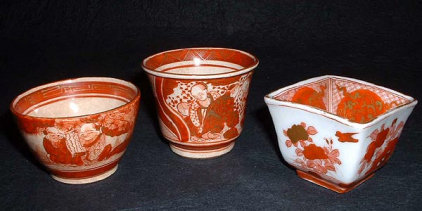|


Three Kutani Hai
Story by Robert Yellin
First Published YAKIMONO.net April 2003

When I first came to Japan in 1984 I used to always look forward to Sunday mornings. If you think it was because I was going to church then you're wrong. In a different way I was going to "church" in a non-religious way -- I was going to the "Church of the Antique Gods."
I would rise at dawn -- well, as close as I could -- and get to some local shrine as quick as I could to go antique hunting. That's right, I was religiously addicted to antique markets. At first I would buy a wide array of things: tansu, woodblock prints, hibachi, kimono, statues and pottery. After a while my small apartment was overflowing with stuff and that's when I decided to concentrate on ceramics and in particular on shuki or ceramics used for drinking sake.
 Like most gaijin, the ceramic items that first fascinated me were colorful porcelains such as Imari and Arita. I was really charmed by Kutani back then and especially examples of red Kutani. Soon after, however, I was smitten by the yakishime bug and I hardly looked at Kutani again. Until a few days ago, that is. Like most gaijin, the ceramic items that first fascinated me were colorful porcelains such as Imari and Arita. I was really charmed by Kutani back then and especially examples of red Kutani. Soon after, however, I was smitten by the yakishime bug and I hardly looked at Kutani again. Until a few days ago, that is.
In my shuki room amongst all the browns of my Bizen guinomi, these three Kutani sake cups caught my eye after sitting there so unobtrusively for years and years. 'Hey,' I thought, 'look at these little charmers!' It was like an old voice echoing in my mind.
Indeed, the cups do have their own quirky charms and I held them in my hands turning them over and over and admiring the little people and designs painted on each. One is so sad and forlorn, another is contemplative and serene while the third is a walk through a delicate garden.

 
The tallest has an abstract design often seen on older textiles and Oribe pieces. The lattice design is very very minute and intricately drawn -- "ii shogoto desu ne!" (A popular phrase used by ceramic art dealer-TV personality Nakajima Shunosuke meaning "what fine work.")
Yet on the other side all the joy is gone and it looks like these folks are in mourning, heads titled down. Some don't even have faces! Very ghostly and it gives me the creeps -- don't like to use this cup that often or when I do I only look at one side.
Not so with the smallest cup. These literati folks are having a little picnic underneath some grand trees. One appears to be holding a cup, probably filled with sake, while the others are reading or discussing the merits, or lack of, on a hanging scroll -- a charming scene. I think the drawing is much better on this cup than the taller one and the talented use of the rounded form very much reminds me of how Ninsei painted his lovely tea jars.

 
The third cup is a delight as well and quite rare in its shape. The four sides each have a floral pattern while the inside is just amazing. So refined with delicately drawn patterns of waves or checks. It really shows the precise craftsmanship of these artisans. Yet, I'm not sure what is at the bottom of this cup as I imagine they wanted to paint two dragons but it ended up looking more like two geckos! In any case, I wonder at what kiln it was made -- so many interesting ones such as the Kasugayama, Minzan, Wakasugi Ono, Yoshidaya, and Miyamotoya kilns amongst a few others. Where were these pieces made I wonder, and how did they end up at my "church."

 
LEARN MORE ABOUT KUTANI WARE
|